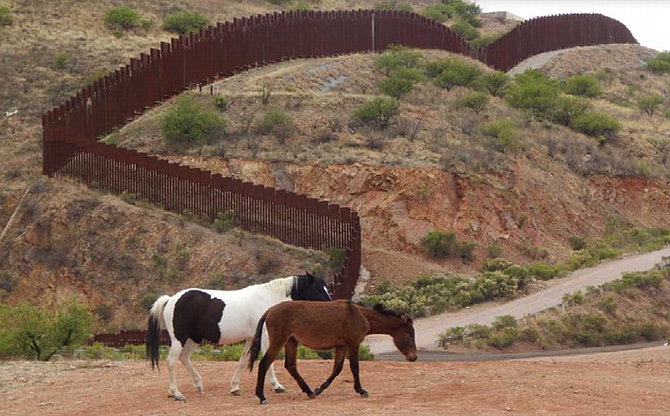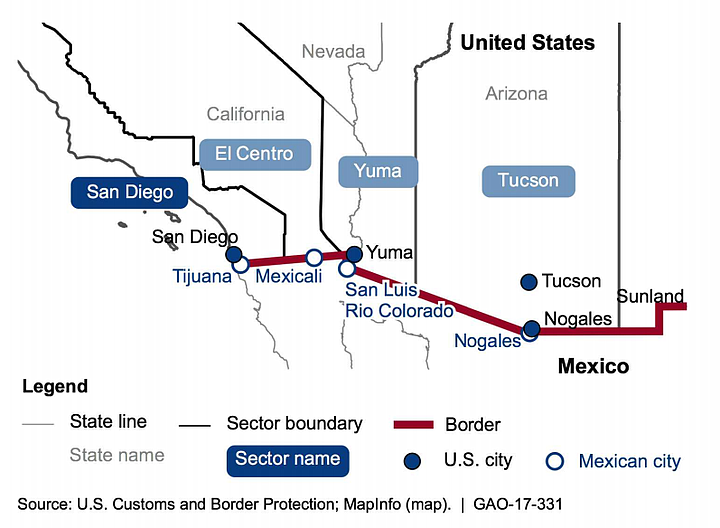 Facebook
Facebook
 X
X
 Instagram
Instagram
 TikTok
TikTok
 Youtube
Youtube

As Donald Trump and his Republican allies in Congress ponder how to pay for the president's promised wall along the Mexican border, a new study from the Government Accountability Office contends that the Department of Homeland Security’s U.S. Customs and Border Protection division lacks adequate information regarding performance of the country's existing multibillion-dollar barrier with Mexico — what the report collectively calls "tactical infrastructure.”

"In an effort to secure the border between ports of entry, [Customs and Border Protection] spent approximately $2.4 billion between fiscal years 2007 and 2015 to deploy [tactical infrastructure] — fencing, gates, roads, bridges, lighting, and drainage infrastructure — along the nearly 2,000 mile southwest border," notes the February 16 report to Congress, entitled, “Additional Actions Needed to Better Assess Fencing's Contributions to Operations and Provide Guidance for Identifying Capability Gaps.”
Though the Border Patrol currently "collects data that could help provide insight into how border fencing contributes to border security operations, including the location of illegal entries,” the agency "has not developed metrics that systematically use these, among other data it collects, to assess the contributions of border fencing to its mission."
The failure is nothing new, say auditors.
"In September 2009, we found that [Customs and Border Protection] had not assessed [tactical infrastructure's] impact on border security operations or mission goals and had not measured the effectiveness of [tactical infrastructure]. Specifically, we found that [Customs and Border Protection] had not accounted for the impact of its investment in border fencing and infrastructure on border security."
In particular, auditors said they found that Border Patrol officials in San Diego were unable to provide adequate numbers to back up their claims that by pushing the flow of immigration to rural crossings in East County they had improved enforcement rates.
"Border Patrol officials in the San Diego sector told us that from 1994 to present, pedestrian fencing, along with investments in manpower and surveillance technology, assisted in diverting a large share of illicit cross-border activity away from the densely populated urban areas near San Diego and into more rural and remote environments east of the city," per the report.
"Officials told us that these rural and remote environments east of San Diego provide an advantage to agents assigned there since they have more time to detect, identify, classify, track, respond and resolve the illicit cross-border activities that occur there."

But more hard data, as opposed to the Border Patrol's largely anecdotal accounts of success, according to the audit, is required "to determine the extent to which border fencing diverts illegal entrants into more rural and remote environments, and border fencing’s impact, if any, on apprehension rates over time."
Immigration officials blamed budget cuts for the lack of detailed information regarding their enforcement activities. "According to [Customs and Border Protection] officials, CBP suspended its efforts to measure the contributions of border fencing to border security in 2013 due to sequestration related funding shortfalls," says the report.

The practice of shifting immigrants from Mexico into the desert — begun under 1994's Project Gatekeeper during the administration of Democratic president Bill Clinton, as overseen by so-called border czar Alan Bersin — has long been controversial, with one of the most prominent critics being Enrique Morones, who founded Border Angels in 2001 to provide water stations and other aid to stranded border-crossers.
"Usually, gallon bottles of water are placed in blue plastic barrels topped with a blue flag at the end of a 30-foot pole or with a flashing red light like those used on bikes," wrote Stephen Dobyns in a December 7, 2006, profile of the group.
“Beginning in January 2002, the Border Angels also set up cold-weather stations in Cleveland National Forest in East County, with blankets, sleeping bags, clothing, food, and water. The water stations tend to be along power lines or paths that migrants have taken in the past. In Imperial Valley about 40 are located at the edge of the desert along Route 98 between Calexico and Interstate 8."
Said Morales, "The Border Patrol calls Operation Gatekeeper a success. I would like you to ask the mothers of the people who have died crossing the desert and see if they call it a success."
Added his associate and mentor, Roberto Martinez, former director of the Border Project for the American Friends Service, "The wall is responsible for pushing migrants into dangerous areas. Now they want a triple wall from the ocean to Otay Mesa. The walls are largely symbolic, since migrants can go around them, but they've led to many deaths. I believe two or three people die every day trying to cross the border. Instead of 4000, it could easily be 11,000 who've died in the past 11 years. For every body that's found, there are two or three that are not found."
At the dawn of yet another barrier-building effort under Trump, the government's audit indicates that enforcement officials have a costly wish list for the new fence.
"Border Patrol officials we spoke with in the El Paso, Tucson, and San Diego sectors stated that modern pedestrian fencing, including bollard style fencing, improves agent safety during operations. Specifically, San Diego sector officials told us that modern style pedestrian fencing reduces illegal entrants’ ability to stage mass crossings, which can overwhelm agents and jeopardize agents’ safety."
Adds the report, "the locations of apprehensions, turn-backs, got-aways, and drive-throughs with the various types and designs of fencing at the sector and zone level in conjunction with information on geography, demographics, staffing, technology, and other [tactical infrastructure] could help [Customs and Border Protection] assess the contributions of border fencing to border security operations as well as current and future fencing deployments and replacement projects in light of other resource allocation priorities."
Or, in other words, conclude the auditors, “An assessment of border fencing’s contributions to border security operations could help position CBP to identify the cost effectiveness of border fencing compared to other assets the agency deploys."


As Donald Trump and his Republican allies in Congress ponder how to pay for the president's promised wall along the Mexican border, a new study from the Government Accountability Office contends that the Department of Homeland Security’s U.S. Customs and Border Protection division lacks adequate information regarding performance of the country's existing multibillion-dollar barrier with Mexico — what the report collectively calls "tactical infrastructure.”

"In an effort to secure the border between ports of entry, [Customs and Border Protection] spent approximately $2.4 billion between fiscal years 2007 and 2015 to deploy [tactical infrastructure] — fencing, gates, roads, bridges, lighting, and drainage infrastructure — along the nearly 2,000 mile southwest border," notes the February 16 report to Congress, entitled, “Additional Actions Needed to Better Assess Fencing's Contributions to Operations and Provide Guidance for Identifying Capability Gaps.”
Though the Border Patrol currently "collects data that could help provide insight into how border fencing contributes to border security operations, including the location of illegal entries,” the agency "has not developed metrics that systematically use these, among other data it collects, to assess the contributions of border fencing to its mission."
The failure is nothing new, say auditors.
"In September 2009, we found that [Customs and Border Protection] had not assessed [tactical infrastructure's] impact on border security operations or mission goals and had not measured the effectiveness of [tactical infrastructure]. Specifically, we found that [Customs and Border Protection] had not accounted for the impact of its investment in border fencing and infrastructure on border security."
In particular, auditors said they found that Border Patrol officials in San Diego were unable to provide adequate numbers to back up their claims that by pushing the flow of immigration to rural crossings in East County they had improved enforcement rates.
"Border Patrol officials in the San Diego sector told us that from 1994 to present, pedestrian fencing, along with investments in manpower and surveillance technology, assisted in diverting a large share of illicit cross-border activity away from the densely populated urban areas near San Diego and into more rural and remote environments east of the city," per the report.
"Officials told us that these rural and remote environments east of San Diego provide an advantage to agents assigned there since they have more time to detect, identify, classify, track, respond and resolve the illicit cross-border activities that occur there."

But more hard data, as opposed to the Border Patrol's largely anecdotal accounts of success, according to the audit, is required "to determine the extent to which border fencing diverts illegal entrants into more rural and remote environments, and border fencing’s impact, if any, on apprehension rates over time."
Immigration officials blamed budget cuts for the lack of detailed information regarding their enforcement activities. "According to [Customs and Border Protection] officials, CBP suspended its efforts to measure the contributions of border fencing to border security in 2013 due to sequestration related funding shortfalls," says the report.

The practice of shifting immigrants from Mexico into the desert — begun under 1994's Project Gatekeeper during the administration of Democratic president Bill Clinton, as overseen by so-called border czar Alan Bersin — has long been controversial, with one of the most prominent critics being Enrique Morones, who founded Border Angels in 2001 to provide water stations and other aid to stranded border-crossers.
"Usually, gallon bottles of water are placed in blue plastic barrels topped with a blue flag at the end of a 30-foot pole or with a flashing red light like those used on bikes," wrote Stephen Dobyns in a December 7, 2006, profile of the group.
“Beginning in January 2002, the Border Angels also set up cold-weather stations in Cleveland National Forest in East County, with blankets, sleeping bags, clothing, food, and water. The water stations tend to be along power lines or paths that migrants have taken in the past. In Imperial Valley about 40 are located at the edge of the desert along Route 98 between Calexico and Interstate 8."
Said Morales, "The Border Patrol calls Operation Gatekeeper a success. I would like you to ask the mothers of the people who have died crossing the desert and see if they call it a success."
Added his associate and mentor, Roberto Martinez, former director of the Border Project for the American Friends Service, "The wall is responsible for pushing migrants into dangerous areas. Now they want a triple wall from the ocean to Otay Mesa. The walls are largely symbolic, since migrants can go around them, but they've led to many deaths. I believe two or three people die every day trying to cross the border. Instead of 4000, it could easily be 11,000 who've died in the past 11 years. For every body that's found, there are two or three that are not found."
At the dawn of yet another barrier-building effort under Trump, the government's audit indicates that enforcement officials have a costly wish list for the new fence.
"Border Patrol officials we spoke with in the El Paso, Tucson, and San Diego sectors stated that modern pedestrian fencing, including bollard style fencing, improves agent safety during operations. Specifically, San Diego sector officials told us that modern style pedestrian fencing reduces illegal entrants’ ability to stage mass crossings, which can overwhelm agents and jeopardize agents’ safety."
Adds the report, "the locations of apprehensions, turn-backs, got-aways, and drive-throughs with the various types and designs of fencing at the sector and zone level in conjunction with information on geography, demographics, staffing, technology, and other [tactical infrastructure] could help [Customs and Border Protection] assess the contributions of border fencing to border security operations as well as current and future fencing deployments and replacement projects in light of other resource allocation priorities."
Or, in other words, conclude the auditors, “An assessment of border fencing’s contributions to border security operations could help position CBP to identify the cost effectiveness of border fencing compared to other assets the agency deploys."
Comments